Communication is what it does! And what it does is what we want it to do. There is a fundamental human intent to impress others and get the desired feedback from them. All this happens via communication. Now, what we make out of Communication is the question that keeps a lot of focus here.
Defining Communication Skills and Screening the ‘Implicit Scope’
My Understanding of Communication: The Common, still the Uncommon
We might belong to different continents, nations, provinces, cities, towns, and villages, yet we do have belonging with ourselves, ourselves-our family and friends, which subsequently makes us reciprocate to the society we live in. We, irrespective of the diversity and differences, try to remember -or to find out the first words being voiced by the newly born. These articulations are remembered throughout our lives and are cherished, too. It is not without reason that we celebrate the very first ‘Communication’ we receive from the new member of the family; it is the fundamental fascination we have in life, and we have kept it alive since we got the ‘communicative competence’.
How do we (I willingly avoid saying you) react to the word ‘communication’? Certainly, we, despite having a shared goal to define it, shall not be able to pronounce a uniform conceptual understanding of the term. Let’s avoid taking encyclopedic references from Google or the associated pedias; otherwise, we will be polarising as well as plagiarising our thought process.
I must make it clear that I don’t take sides with those who say that it is very difficult to define communication; ironically, they still define it there and then in the same write-up. Reaching a single, uniform set of words in the definition is humanly impossible, and that is the most welcoming thing in communication. It is not a science; rather, it is a human science where you have to study the ‘behavioural responses and reactions’ and develop the capacity to predict the possible demeanour of the other person/pole in communication. The uniformity does not come by bringing the same set of words; it is by default present as they are all conferencing about the same domain.
In this first brainstorming session, I wish to share a very simple activity I have been conducting with my fellow learners (students assigned to me). It needs a board marker, or if you are fortunate enough to find a tennis ball with a student's name on it. Then, it is as simple as making tea with the ‘readymade’ contents!
We start a childhood favourite Catch-Catch game, and like an accustomed singer-performer, I keep on speaking about Communication. There are two things happening: Listening and artificially created Involvement. Reciting the remembered, as Kant says, “Communication is the transfer of information from a sender to a receiver, with the information being understood by the receiver.” I have made this definition a part of my being since I first read it to students (of course, I mean fellow learners) in 2007. The fundamentals that it conveys are so clear to us and seem identical to the Catch-Catch we have been playing in the background. On the foregrounded screen, the scope of the process is explained to the listeners, who have identified the throw-catch-throw as the process of communication, comprising the medium-message in their own tennis ball.
It seems more justified to tell them now that communication is all-pervasive, it is an exchange of information, facts, expressions or emotions, goal-oriented as well as bipolar. The various mannerisms of throwing the same Message-Medium ball to the receiver bring out the Verbal and Non-Verbal types of communication. Interestingly, the failures in grabbing the ball perfectly stand for a thesis that ‘perfect communication is never possible in practice'.
Referring back to the obvious irony in defining communication, it must be understood that defining (to impose your version on the world) and understanding are altogether different areas. The latter I belong to, and I do it with pride. Understanding Communication seems more rational than defining it. I am of the belief that a substance, which changes its form in different conditions, cannot be confined to a set of words. Communication is all-pervasive; we acknowledge it as gospel truth, and we are required to acknowledge that it is ‘ever-evolving' too. Thus, something in transition cannot be restricted, as this would invite a new set of definitions every calendar day.
As a teacher, I feel that ‘Ethical Double-Speak’ is a virtue for us. We need to create discontent (never disappointment) among learners and need to invite them to search for the ‘logical conclusion’ to the discussion on communication in a ‘given context’. The hunger to experience and discover the scope of communication is what proves to be an asset for us.
While concluding this Introductory, of my understanding, and writing random thoughts about communication, I must share the observations by an expert famous with all teachers- P.D. Chaturvedi and Mukesh Chaturvedi:
- What is communication? Communication is what it does-bringing people together.
- How does it do that? By establishing a commonness among people.
Communication is divided into Verbal and Non-Verbal types according to the 'usage or the tools used to communicate'.
Verbal Communication:
- Verbal Oral (Spoken) Communication
- Verbal Written Communication
Non-Verbal Communication:
- Face Expressions
- Gestures
- Eye Contact
- Pitch
- Tone
- Para-Language
Non-verbal communication can be better understood with the explanation of KOPPACT.
We shall discuss it in upcoming posts and discussions.







